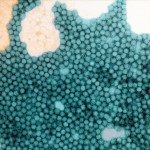Lien vers Pubmed [PMID] – 10964776
Virology 2000 Sep;274(2):331-42
Poliovirus (PV) is able to establish persistent infections in human neuroblastoma IMR-32 cells [Colbère-Garapin et al. (1989) Proc. Natl. Acad. Sci. USA 86, 7590]. During persistent infection, PV mutants are selected that display substitutions of residues in regions of the capsid known to interact with the PV receptor (PVR), a glycoprotein of the immunoglobulin superfamily. The mechanism of persistent infection in IMR-32 cells may therefore involve the selection of mutant PVRs. To test this hypothesis, the sequences of the PVR mRNAs in uninfected IMR-32 cells and in two independent IMR-32 cell cultures persistently infected with the Mahoney strain of PV type 1 (PV1/Mahoney) were determined. The PVR mRNA population of uninfected cells was homogeneous, and no mutation was repeatedly found, whereas that of persistently infected cells displayed missense mutations. Particular mutations were repeatedly detected, and all of them mapped to the N-terminal domain of PVR (domain 1), which interacts directly with PV. These mutations generated several types of PVR variants with the following substitutions: Ala67–>Thr alone, Ala67–>Thr associated with Gly39–>Ser, and Arg104–>Gln. Functional analysis of PVR in murine LM cells, stably expressing each of the PVR forms, showed that the PVR forms selected during persistent infection conferred on LM cells partial resistance to PV1/Mahoney-induced lysis. Although adsorption onto PVR seemed to be independent of the PVR form, an analysis of the conformational changes of the capsid during the early steps of the PV cycle provided evidence that the Ser39/Thr67 and Gln104 substitutions almost halved the conversion of 160S infectious particles into 135S A particles associated with the PV-PVR interaction. Altogether, these findings indicate that during persistent infection, specific mutations were selected in the domain 1 of PVR and that these mutations increased the resistance of cells to PV-induced lysis. These results are discussed in view of the position of the mutations on PVR.

